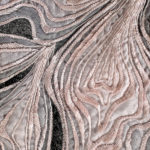One of our biggest inspirations throughout our life and career has been art, and growing up in India and England, we’ve been lucky enough to be exposed to art in various forms and mediums, from tribal and traditional to the most influential of Western artists like Matisse & Picasso. Having access to places like the V&A and National Portrait Gallery has been a blessing and has shaped our career path and passion for designing and creating. We love being able to convey different feelings and moods through our embellishments, through the colours, the textures and the composition. There is a story behind each of our embroideries, and each and every piece holds memories and recollections of a special point in time or place. As we delve back through our archives, we have picked out one of our favourite embroideries to tell its story from inspiration through to creation.
Based in India, we are surrounded by ancient folk art that has been passed down through generations, and is still portrayed today through religious and cultural imagery. Created by cultural tribes and groups and passed down through generations, traditional folk art has an endearing handcrafted quality and rough-hewn finish. The imperfections are what give this art form its charming and distinctive characteristic. Traditionally created out of twigs, fingers, wood, straw, or whichever tools were available, its pure and almost childlike quality evokes so much emotion and tell a unique story that pristine pens and brushes never could. Traditional folk art is such an important part of Indian culture and everyday life, that the rich colours and wonderful stories behind each image adorn the walls and picture frames of our daily lives, and very much evoke a feeling of “home”.

Picture Source: www.craftsvilla.com
We looked further into traditional folk art from other cultures and backgrounds, and came across beautifully moving and emotive works of art from world over, each with their own distinctive cultural themes and history. Be it British, Japanese, Aboriginal or Indian, each region has its own stories to tell and own timeline to chalk out. But we found a similarity in the sentiment– a certain vulnerability about the drawings, and a simplicity in the art that draws the viewer in with ease and without pretense.

Picture Source: fineartofamerica.com

Picture Source: https://britishfolkartcollection.org.uk
We wanted to recreate this emotion through our embroidery, but without constraining our piece to a particular culture or region. We’ve used a hand thread embroidery and a freehand line to portray the simplicity and earthy nature of traditional folk art, and have depicted the faces of girls who could belong to any era or any place.

The distorted and imperfect quality of handmade folk art displays elements that remind us somewhat of modern art movements like cubism and surrealism. Where proportions are played with, imaginations run free and dreams and thoughts can be expressed without structure or boundaries. The artist can create their own distorted version of reality and the viewer is free to draw their own interpretations. Through travelling we are lucky enough to view so many different types of art and draw inspiration from different countries, cultures, sights and sounds. This embroidery piece is a collection of our influences from all over the globe and represents our passion for art in all its amazing and inspiring glory.
At Ricamour Embroideries, we love creating new designs. Our Process ensures couture-standard workmanship and high quality components so our Clients enjoy the highest possible finish. Explore innovative ways to personalise your bride’s dream gown in our recent blog- Embroidered with Love.
Write to us on info@ricamour.com or WhatasApp us to create a free sample and to see our collection of Couture and bridal designs, sashes & trims and more.















